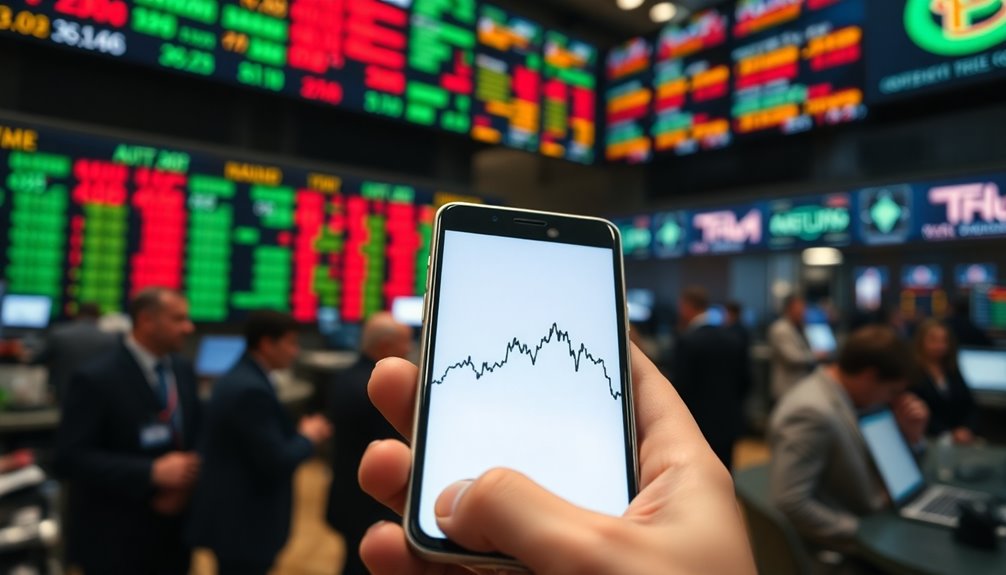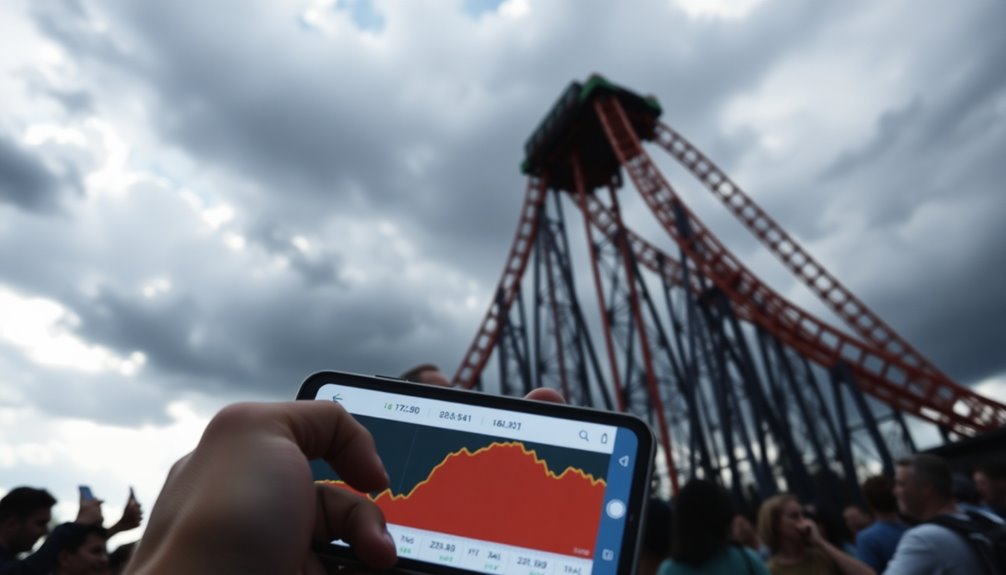A volatile investment is an asset that shows significant price swings in a short time, often attracting those seeking high returns. These investments, like certain stocks, can yield annualized returns over 10%, but they also come with increased risks, including the potential for substantial losses. You'll notice daily price movements exceeding 1%, which can be exciting for short-term traders. However, emotional discipline is key to avoid impulsive decisions. Understanding how to navigate volatility is crucial for maximizing your portfolio's potential. If you stick around, you'll uncover more insights about managing these investments effectively.
Key Takeaways
- Volatile investments experience significant price fluctuations over short periods, leading to both potential gains and losses.
- Investments with a beta greater than 1 are considered more volatile than the overall market.
- High volatility often results in higher annualized returns, historically exceeding 10%.
- Emotional discipline is crucial when investing in volatile assets to avoid impulsive decisions.
- Diversification strategies can help mitigate the risks associated with volatile investments.
Volatility's Impact on Returns

While volatility can feel daunting, it often plays a crucial role in shaping investment returns. By embracing volatility, you open up opportunities for significant gains in your portfolio.
Historical data shows that investments with higher volatility frequently yield annualized returns above 10%, far exceeding those with lower volatility. If you strategically exploit market fluctuations—like buying dips or using options strategies—you can enhance your returns while managing risks.
However, keep in mind that volatility can lead to greater losses during downturns, highlighting its dual nature. A well-diversified portfolio that includes volatile investments can improve your long-term growth potential, turning market corrections into buying opportunities, and ultimately helping you navigate the intricate landscape of investments effectively.
Defining Volatile Investments Clearly

Understanding volatile investments is vital for navigating the intricacies of the market. These securities experience significant price fluctuations over short periods, often marked by a high standard deviation in returns.
Higher volatility typically indicates greater risk, as these investments can see price swings exceeding 1% daily. Stocks with a beta greater than 1, like those with a beta of 1.2, are more volatile than the overall market.
Implied volatility serves as a key measure of market expectations for future volatility, influencing options pricing and strategies.
While volatile investments present opportunities to capitalize on rapid price changes, they also increase the chances of substantial capital losses.
Balancing risk and reward is essential for successful navigation.
Price Fluctuations Over Time

Price fluctuations over time can significantly impact your investment strategy, especially when dealing with volatile assets. High volatility means you're likely to see daily price movements exceeding 1%, which can create both opportunities and risks.
For instance, the CBOE Volatility Index (VIX) offers insights into expected market volatility, helping you gauge potential price fluctuations. While short-term traders often capitalize on rapid price movement for quick gains, you should also be wary of the inherent market risk.
Volatile investments might offer annualized returns above 10%, but they come with a higher chance of capital loss. Understanding standard deviation can help you assess past price changes, so you can better navigate the ups and downs of your investments.
Pros and Cons Overview

Investing in volatile assets can be a double-edged sword, offering both exciting opportunities and significant risks.
On one hand, volatile investments can yield higher long-term returns, with historical performance showing annualized gains exceeding 10%. However, the significant price fluctuations associated with these assets can lead to substantial capital losses, especially for short-term investors caught in market downturns.
Emotional discipline is crucial; impulsive decisions during volatility can derail your investment goals. To mitigate risks, consider diversification strategies that spread your investments across various asset classes, reducing overall portfolio volatility.
Additionally, options pricing models like Black-Scholes reflect the elevated premiums of higher volatility investments, underscoring the potential for profit in uncertain markets, but also the risks involved.
Volatility Versus Stability Analysis

The landscape of investments is often defined by a stark contrast between volatility and stability.
Volatile investments, marked by significant price fluctuations, present a higher risk that can attract long-term investors during market dips. They often utilize metrics like beta to gauge their potential, where a beta greater than 1 indicates increased volatility.
In contrast, stable investments display steadier movements, appealing to conservative investors who seek consistent growth.
The CBOE Volatility Index (VIX) serves as a barometer for market anxiety; higher values signal elevated risk associated with volatile assets.
While short-term investors may shy away from such fluctuations, long-term investors might seize the opportunity for potential gains, illustrating the delicate balance between risk and reward in the investment landscape.
Market Timing Difficulties

Navigating market timing in volatile investments can feel like chasing shadows, as unpredictable price movements often exceed 1% within a single trading session. This unpredictability makes it tough for you to pinpoint optimal entry and exit points.
Historical volatility may mislead you, as it doesn't account for future market conditions, leading to missed opportunities or unanticipated losses. The CBOE Volatility Index (VIX) serves as a barometer for expected market volatility; rising values signal heightened uncertainty, complicating your timing decisions.
Additionally, emotional responses to short-term volatility can prompt impulsive trading decisions, locking in losses. To succeed, you'll need advanced technical analysis and a disciplined approach, as rapid price swings can result in significant deviations from expected returns.
Emerging Market Volatility Spikes

Emerging markets can be a rollercoaster ride, with volatility spikes often driven by factors like political unrest, economic shifts, and fluctuating commodity prices.
You'll notice that these markets experience significant market volatility, often showing average annual volatility rates exceeding 20%, especially during times of economic fluctuations.
Political instability can lead to sudden capital outflows, resulting in abrupt price movements that impact your investment value. Additionally, currency fluctuations can further exacerbate volatility, swinging local currencies against major global currencies.
Historical data reveals that drawdowns can exceed 30% within a single year in emerging market indices, highlighting the potential for rapid and extreme shifts in investment value compared to more stable markets. Understanding this risk is crucial for navigating these unpredictable waters.
Investors should also consider diversification strategies to mitigate the risks associated with emerging market investments.
Diversify Across Asset Classes

While you might feel tempted to concentrate your investments in high-growth areas, diversifying across asset classes is a smarter strategy to manage risk and volatility.
When stock prices fluctuate, volatility increases, affecting individual securities. By spreading your investments across equities, fixed income, and alternative investments like real estate or hedge funds, you can reduce overall volatility.
Each asset class reacts differently to market events, providing stability when some assets decline. Research shows that diversified portfolios can achieve risk-adjusted returns exceeding 10% annually over the last decade. Additionally, incorporating real estate IRAs can further enhance diversification and potential income streams.
Regularly reviewing your portfolio with a financial advisory ensures your allocations align with your goals, helping you effectively manage volatility and navigate market index changes.
Frequently Asked Questions
What Is the Meaning of Volatile Investment?
When you hear the term "volatile investment," it refers to assets that experience significant price swings in a short time.
These fluctuations can create both risks and opportunities for you as an investor. You might see prices rise or fall dramatically, which can lead to higher potential returns, but also greater losses.
Understanding volatility helps you evaluate your risk tolerance and make informed decisions about your investment strategy in changing market conditions.
What Is an Example of Volatility?
Did you know that Bitcoin can swing over 10% in just one day? That's a prime example of volatility.
When you watch the cryptocurrency market, you'll see these dramatic price shifts happen frequently. Imagine waking up to find your investment has gained or lost thousands overnight!
This unpredictability can create both excitement and anxiety, reflecting how market sentiment and news events can dramatically influence asset prices, making your investing experience quite thrilling.
Are Volatile Stocks Good?
Are volatile stocks good? It depends on your investment strategy and risk tolerance.
If you're comfortable with price swings, you might find opportunities for quick profits. However, you should also be aware of the potential for significant losses.
By using strategies like buying dips or protective puts, you can manage risks effectively.
Always keep an eye on market sentiment and economic indicators to make informed decisions about your investments.
What Are the Four Types of Volatility?
You might think all volatility is bad, but it's not that simple. There are four types of volatility to consider.
First, historical volatility measures past price swings.
Then, implied volatility reflects market expectations for future movements.
Realized volatility shows what's actually happened over time, while structural volatility accounts for changes in market conditions or regulations.
Understanding these can help you navigate risks and rewards in your investment strategy effectively.
Conclusion
In the world of investing, volatile investments can feel like a wild roller coaster ride—thrilling yet unpredictable. While they offer the potential for high returns, the risks can be daunting. It's essential to weigh the pros and cons carefully and consider your risk tolerance. By diversifying across asset classes, you can ride the ups and downs with more confidence. Remember, balancing your portfolio is key to navigating the twists and turns of the market successfully.









